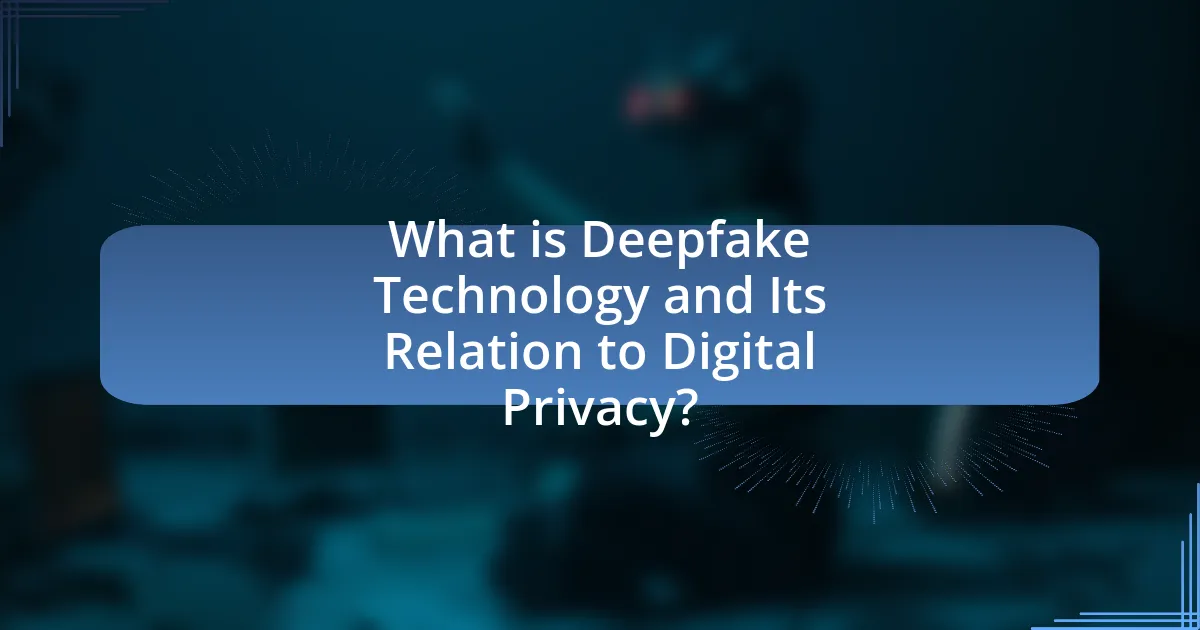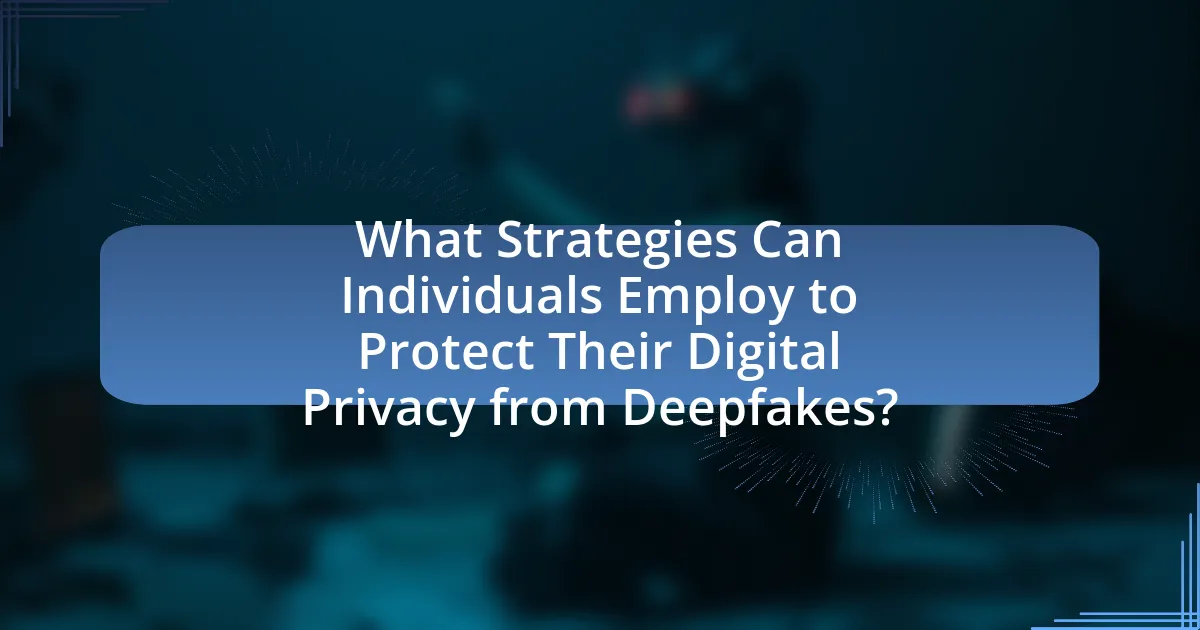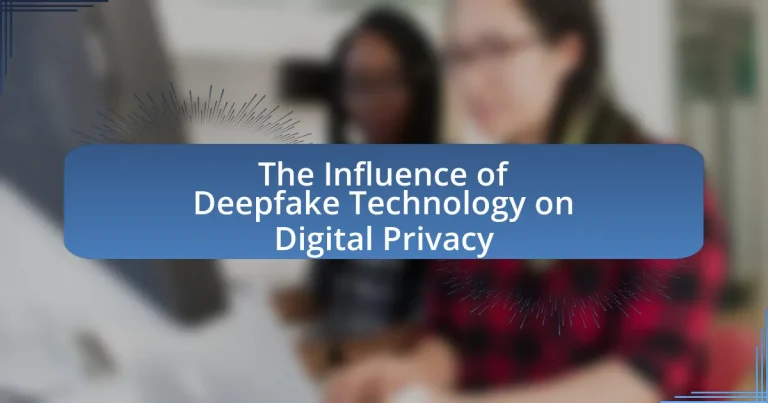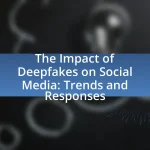Deepfake technology utilizes artificial intelligence to create realistic fake videos and audio recordings, raising significant concerns regarding digital privacy. This article explores how deepfakes work, their implications for identity theft and misinformation, and the societal impact on trust in digital media. It also examines existing legal frameworks, proposed regulations, and strategies individuals can employ to protect their digital identities from deepfake-related risks. Key components such as generative adversarial networks and the role of algorithms in deepfake creation are discussed, alongside the importance of media literacy and detection tools in identifying manipulated content.

What is Deepfake Technology and Its Relation to Digital Privacy?
Deepfake technology refers to artificial intelligence-based methods that create realistic-looking fake videos or audio recordings by manipulating existing media. This technology poses significant risks to digital privacy, as it can be used to create misleading content that impersonates individuals, potentially leading to identity theft, misinformation, and reputational harm. For instance, a study by the University of California, Berkeley, found that deepfake videos can be convincingly realistic, making it difficult for viewers to discern truth from fabrication, which raises concerns about the erosion of trust in digital media.
How does Deepfake Technology work?
Deepfake technology works by using artificial intelligence, specifically deep learning algorithms, to create realistic-looking fake videos or audio recordings. This process typically involves training a neural network on a large dataset of images or audio samples of a person, allowing the model to learn their facial expressions, voice patterns, and other unique characteristics. Once trained, the model can generate new content that mimics the original subject, making it appear as though they are saying or doing something they did not actually do. The effectiveness of deepfakes is supported by advancements in generative adversarial networks (GANs), which pit two neural networks against each other to improve the quality of the generated content.
What are the key components of Deepfake Technology?
The key components of Deepfake Technology include generative adversarial networks (GANs), deep learning algorithms, and large datasets of images and videos. GANs consist of two neural networks, a generator and a discriminator, that work together to create realistic synthetic media by learning from existing data. Deep learning algorithms enable the analysis and manipulation of visual and audio content, allowing for the seamless integration of altered elements. Large datasets are crucial as they provide the necessary training material for the models to learn facial expressions, voice patterns, and other characteristics, ensuring the generated content closely resembles real individuals.
How do algorithms contribute to the creation of deepfakes?
Algorithms play a crucial role in the creation of deepfakes by utilizing machine learning techniques, particularly generative adversarial networks (GANs). GANs consist of two neural networks: a generator that creates fake images or videos and a discriminator that evaluates their authenticity. This adversarial process allows the generator to improve its outputs based on feedback from the discriminator, resulting in increasingly realistic deepfakes. Research by Karras et al. (2019) in “A Style-Based Generator Architecture for Generative Adversarial Networks” demonstrates how advanced algorithms can produce high-quality synthetic media that is difficult to distinguish from real content.
What are the potential implications of Deepfake Technology on digital privacy?
Deepfake technology poses significant risks to digital privacy by enabling the creation of highly realistic but fabricated audio and visual content. This capability can lead to identity theft, as individuals’ likenesses can be manipulated without consent, resulting in unauthorized use in misleading contexts. For instance, a study by the University of California, Berkeley, highlights that deepfakes can be used to create false narratives, potentially damaging reputations and privacy. Furthermore, the proliferation of deepfake content complicates the verification of authentic media, making it challenging for individuals to trust the information they encounter online, thereby undermining personal privacy and security.
How can deepfakes be used to violate personal privacy?
Deepfakes can be used to violate personal privacy by creating realistic but fabricated audio or video content that misrepresents individuals. This technology allows malicious actors to superimpose someone’s likeness onto another person’s body or manipulate their speech, leading to potential defamation, harassment, or identity theft. For instance, a study by the University of California, Berkeley, found that deepfake technology can produce highly convincing fake videos that can be used to spread misinformation or damage reputations, illustrating the significant risks to personal privacy.
What are the risks associated with deepfake technology in terms of identity theft?
Deepfake technology poses significant risks for identity theft by enabling the creation of highly realistic fake videos and audio recordings that can impersonate individuals. This capability allows malicious actors to manipulate the identity of victims, leading to unauthorized access to personal information, financial fraud, and reputational damage. For instance, a study by the University of California, Berkeley, found that deepfakes can be used to create convincing impersonations that deceive individuals and organizations, increasing the likelihood of identity theft incidents. Additionally, the rise of deepfake technology has been linked to a 2020 report from the Federal Trade Commission, which indicated a surge in identity theft cases attributed to advanced digital impersonation techniques.
How is Deepfake Technology Impacting Society’s Perception of Digital Privacy?
Deepfake technology is significantly altering society’s perception of digital privacy by raising concerns about the authenticity of digital content and the potential for misuse. As deepfakes become more sophisticated, individuals increasingly question the reliability of videos and images, leading to a heightened awareness of privacy risks. A study by the Pew Research Center found that 51% of Americans believe deepfake technology poses a significant threat to personal privacy, illustrating widespread apprehension regarding manipulated media. This shift in perception is prompting discussions about the need for stronger regulations and tools to protect individuals from privacy violations associated with deepfake creations.
What societal concerns arise from the use of deepfakes?
The use of deepfakes raises significant societal concerns, primarily related to misinformation, privacy violations, and potential harm to individuals’ reputations. Misinformation can spread rapidly through deepfakes, leading to public confusion and distrust in media, as evidenced by incidents where manipulated videos have influenced political events or public opinion. Privacy violations occur when individuals’ likenesses are used without consent, often resulting in emotional distress or reputational damage, as seen in cases where deepfakes have been used for harassment or defamation. Furthermore, the potential for deepfakes to facilitate fraud or identity theft poses a serious risk, with studies indicating that the technology can be exploited to create convincing scams. These concerns highlight the urgent need for regulatory measures and public awareness to mitigate the negative impacts of deepfake technology on society.
How do deepfakes affect trust in digital media?
Deepfakes significantly undermine trust in digital media by creating realistic but fabricated content that can mislead viewers. This technology enables the manipulation of audio and video, making it difficult for individuals to discern authentic media from altered versions. A study by the University of California, Berkeley, found that 96% of participants could not reliably identify deepfake videos, highlighting the potential for misinformation and erosion of credibility in digital platforms. As a result, the prevalence of deepfakes contributes to skepticism towards online content, affecting public perception and trust in legitimate media sources.
What role do deepfakes play in misinformation and disinformation campaigns?
Deepfakes play a significant role in misinformation and disinformation campaigns by enabling the creation of highly realistic but fabricated audio and video content. This technology allows malicious actors to manipulate public perception, spread false narratives, and undermine trust in legitimate media sources. For instance, a study by the University of California, Berkeley, found that deepfake videos can significantly influence viewers’ beliefs, with 96% of participants unable to distinguish between real and manipulated content. This capability poses a serious threat to digital privacy and information integrity, as it can be used to impersonate individuals, create false evidence, and incite social discord.
What legal frameworks exist to address deepfake-related privacy issues?
Legal frameworks addressing deepfake-related privacy issues include existing laws on defamation, copyright, and privacy rights, as well as emerging legislation specifically targeting deepfakes. For instance, California’s AB 730, enacted in 2019, criminalizes the use of deepfakes to harm or defraud individuals, particularly in the context of elections and pornography. Additionally, the federal government has proposed the DEEPFAKES Accountability Act, which aims to establish liability for creators of malicious deepfakes. These frameworks are designed to protect individuals from unauthorized use of their likeness and mitigate the potential harm caused by deceptive digital content.
How effective are current laws in protecting individuals from deepfake misuse?
Current laws are largely ineffective in protecting individuals from deepfake misuse. Existing legal frameworks often struggle to address the unique challenges posed by deepfake technology, which can facilitate misinformation, harassment, and identity theft. For instance, while some jurisdictions have enacted laws targeting non-consensual pornography, these laws may not encompass all forms of deepfake misuse, leaving significant gaps in protection. Additionally, the rapid evolution of deepfake technology outpaces legislative responses, resulting in outdated regulations that fail to adequately safeguard individuals. As of 2023, only a few states in the U.S. have specific laws addressing deepfakes, highlighting the need for comprehensive legal reforms to effectively combat this issue.
What new regulations are being proposed to combat deepfake technology?
New regulations proposed to combat deepfake technology include the introduction of laws that mandate clear labeling of synthetic media and the establishment of penalties for malicious use. For instance, the U.S. Congress has considered legislation that would criminalize the creation and distribution of deepfakes intended to harm individuals or manipulate public opinion, reflecting growing concerns over misinformation and privacy violations. Additionally, the European Union’s Digital Services Act aims to hold platforms accountable for hosting harmful content, including deepfakes, thereby enhancing user protection and transparency.

What Strategies Can Individuals Employ to Protect Their Digital Privacy from Deepfakes?
Individuals can protect their digital privacy from deepfakes by employing strategies such as verifying the authenticity of content, using watermarking technology, and enhancing personal data security. Verifying the authenticity of content involves cross-referencing videos or images with trusted sources to confirm their legitimacy, as deepfakes often lack credible origins. Utilizing watermarking technology can help in identifying manipulated media, as it embeds identifiable information that can signal alterations. Additionally, enhancing personal data security through strong passwords, two-factor authentication, and privacy settings on social media platforms reduces the risk of personal information being exploited to create deepfakes. These strategies are essential in mitigating the risks posed by deepfake technology, which has been shown to manipulate digital content convincingly, thereby threatening individual privacy.
How can individuals identify deepfake content?
Individuals can identify deepfake content by examining inconsistencies in visual and audio elements. Key indicators include unnatural facial movements, mismatched lip-syncing, irregular blinking patterns, and inconsistent lighting or shadows. Research from the University of California, Berkeley, highlights that deepfakes often struggle to replicate human nuances, making these discrepancies noticeable to the trained eye. Additionally, tools like deepfake detection software utilize machine learning algorithms to analyze videos for signs of manipulation, further aiding in the identification process.
What tools are available for detecting deepfakes?
Tools available for detecting deepfakes include Deepware Scanner, Sensity AI, and Microsoft Video Authenticator. Deepware Scanner utilizes machine learning algorithms to analyze videos for signs of manipulation, while Sensity AI employs a combination of computer vision and deep learning techniques to identify altered media. Microsoft Video Authenticator assesses images and videos for authenticity by providing a confidence score regarding their legitimacy. These tools are backed by advancements in artificial intelligence and machine learning, which enhance their effectiveness in identifying deepfake content.
How can media literacy help in recognizing deepfake technology?
Media literacy enhances the ability to recognize deepfake technology by equipping individuals with critical thinking skills necessary to analyze and evaluate digital content. This skill set enables users to discern the authenticity of media by understanding the techniques used in creating deepfakes, such as facial manipulation and audio synthesis. Research indicates that individuals with higher media literacy are more adept at identifying manipulated content; for instance, a study published in the journal “Computers in Human Behavior” found that media literacy training significantly improved participants’ ability to detect deepfakes. Thus, media literacy serves as a crucial tool in fostering skepticism and analytical skills, which are essential for navigating the complexities of digital media and protecting personal privacy.
What best practices can individuals follow to safeguard their digital identities?
Individuals can safeguard their digital identities by implementing strong, unique passwords for each account and enabling two-factor authentication (2FA) wherever possible. Strong passwords should consist of a mix of letters, numbers, and symbols, making them difficult to guess. According to a study by the National Institute of Standards and Technology, using 2FA can significantly reduce the risk of unauthorized access, as it requires a second form of verification beyond just the password. Additionally, individuals should regularly monitor their online accounts for suspicious activity and be cautious about sharing personal information on social media platforms, as oversharing can lead to identity theft.
How can individuals manage their online presence to reduce deepfake risks?
Individuals can manage their online presence to reduce deepfake risks by limiting the amount of personal information and images they share publicly. By adjusting privacy settings on social media platforms, individuals can control who sees their content, thereby minimizing exposure to potential misuse. Research indicates that deepfake technology often relies on publicly available images and videos; therefore, reducing the number of such materials online decreases the likelihood of being targeted. Additionally, individuals should regularly monitor their digital footprint and remove outdated or unnecessary content that could be exploited.
What steps can be taken to report and mitigate the effects of deepfakes?
To report and mitigate the effects of deepfakes, individuals should first document the deepfake content by taking screenshots and noting the source. Reporting the deepfake to the platform hosting the content is essential, as most social media and video-sharing platforms have policies against misinformation and harmful content. Additionally, individuals can report the deepfake to relevant authorities, such as law enforcement or cybersecurity organizations, especially if it involves harassment or defamation.
To mitigate the effects, users can educate themselves and others about deepfakes, promoting awareness of the technology’s capabilities and limitations. Utilizing deepfake detection tools, which are increasingly available, can help identify manipulated content. Furthermore, advocating for stronger regulations and policies regarding the creation and distribution of deepfakes can contribute to broader societal protection against misuse.


